Paska Easter Bread
Traditional Paska Bread makes a sweet and delightful addition to your Easter table. This easy-to-make sweet bread uses pantry staple ingredients to make a soft and tender loaf of bread. Studded with golden raisins and a braided top, this delicious bread is the perfect addition to your Easter celebrations.

My mom’s side of the family is Italian and that is where I get the majority of my Easter recipes; things like Italian Easter Bread, Pigu, Bacon and Cheese Easter Bread, and Italian Easter Pie. On my dad’s side of the family, my grandmother is Polish and my grandfather was Irish. I don’t know as much about those food traditions, but I’m trying to take the opportunity each year to learn more.
A while ago, my grandma shared this recipe for Paska bread with me. She said she got it years ago from a woman she began chatting with at a department store. They talked about recipes and the woman took down my grandma’s address and said she would send her the family’s Paska recipe. Lo and behold, a few days later, a handwritten recipe showed up in my grandma’s mailbox. As someone who loves to talk about food and share recipes, I just love that story!
What is Paska?
When I first set out to make the recipe I wanted to learn a little more about where it originated and how it’s served.
Paska is a traditional Easter bread from Ukraine and eastern Europe. In Russia, this sweet, eggy bread is called Kulich. It’s most often made in the spring to celebrate Easter. The word Paska translates to “Easter” in most eastern European cultures (except Finland where it’s a 4-letter word).
Traditionally, paska bread is made and taken to church Easter morning to be blessed and then brought home to be enjoyed with Easter meals.

Ingredients for Paska Bread
This Paska bread recipe is a traditional brioche dough recipe, enriched with egg yolks and sugar, then studded with golden raisins and baked up. The raisins are optional and you could definitely omit them if you’d like.
- Whole Milk: The milk gives this bread a softer crust and a rich texture.
- Instant Yeast: Helps the bread rise to towering heights.
- Sugar: Sweetens the bread as well as feeds the yeast to help the dough grow.
- Butter: Gives the dough a softer finish similar to a brioche.
- Eggs: Binds the ingredients together while also lending a little color to this bread.
- Vanilla + Salt: All the flavor!
- Flour: I use all-purpose flour in this recipe.
- Raisins: These add a little sweetness and are totally optional- my mom would omit them!
- Egg wash: Made from mixing an egg with water to glaze the top before baking.
- Coarse sugar: For sprinkling on top, optional but highly recommended.
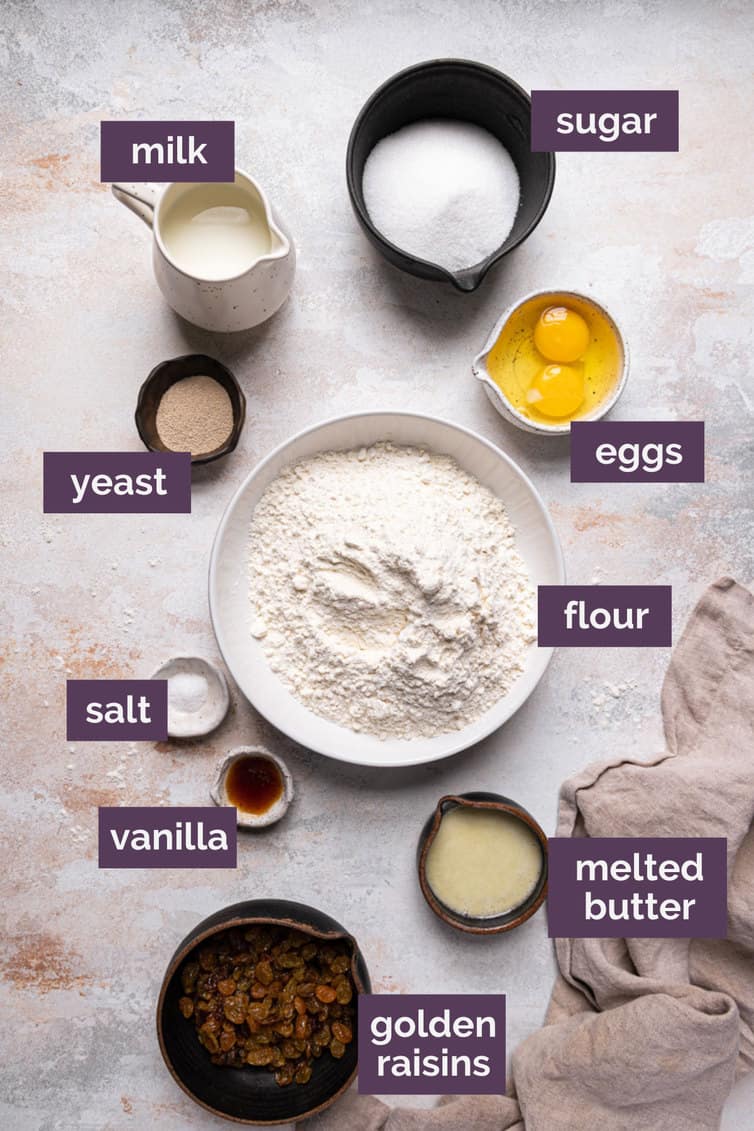
How to Make Paska Bread
I’m breaking this down into steps to walk you through the process; first, we make the dough, then shape the loaf, and bake the bread. Let’s do it!
Save This Recipe
Make the Bread Dough
- Activate the yeast: Warm the milk to a temperature between 100°F and 110°F (usually 30 seconds in the microwave should do the trick). Pour the warmed milk into a mixing bowl and sprinkle the yeast over top and let sit for 5 to 10 minutes, until foamy.

- Add liquid ingredients: Add sugar, butter, eggs, and vanilla to the bowl. Stir to combine.
- Make a shaggy dough: Add the flour and the salt into the bowl. Stir with a wooden spoon until a shaggy dough forms. If using, add the golden raisins.
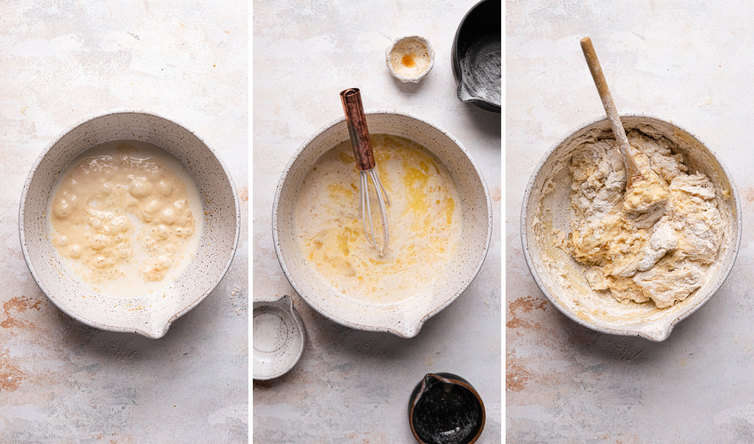
- Knead the dough: Using the dough hook, knead on medium-low speed until a smooth, shiny ball of dough is formed, 3 to 6 minutes, adding additional flour as necessary. (You can also knead by hand until a smooth ball is formed.)
- Let dough rise: Place the dough in a greased bowl and cover with plastic wrap. Place in a warm, draft0free spot until double in size, 1 to 2 hours.

Form and Shape the Dough
- Divide the dough: Punch the dough down and remove it from the bowl to a clean work area. Remove one-quarter of the dough and set aside.
- Shape the base: Form the large piece of dough into a ball and place in a 9-inch round cake pan or a springform pan.
- Braid the dough: Divide the remaining dough into three pieces and roll them each into 20-inch strands. Braid the three strands together for one long braid.
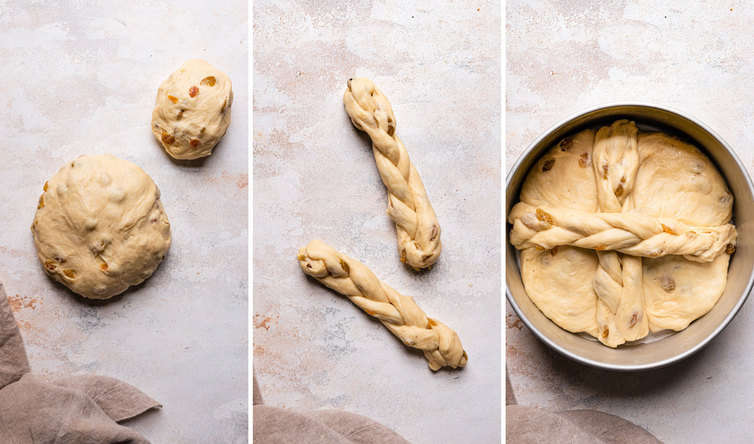
- Top the dough: Divide the braid in half and use it to form a cross over the top of the large ball of dough in the pan. Alternately you can wrap the braid in one length around the inside edge of the pan.
- Allow to rise: Cover lightly with plastic wrap and let rise until puffy and nearly double in size, 45 to 60 minutes.
Bake the Paska Bread
- Set the oven: Preheat the oven to 400°F.
- Make the egg wash: Whisk together the egg and water, then brush evenly all over the top of the dough and sprinkle with sugar.
- Bake the paska: Bake for 15 minutes, then reduce the oven temperature to 350°F and bake for an additional 25 to 30 minutes, until golden brown and an instant-read thermometer registers to 190°F. You can tent the pan with aluminum foil if it is browning too quickly.
- Cool the bread: Remove from the oven, turn the bread out of the pan, and place on a wire rack to cool completely.

Frosting and Glaze
We enjoy this paska bread recipe as is, but if you are looking to sweeten it up even more, try topping the bread with a simple powdered sugar and milk glaze or one of the following:
- Cream cheese frosting
- Vanilla buttercream frosting
- 7 minute frosting
- Orange glaze from my cranberry pound cake
Toppings and Mix-ins
- Traditional topping: Paska is often eaten with hrudka which is a bland, sweet custard similar to cheese.
- Other Toppings: Aside from frosting or a glaze you can top this sweet bread with sprinkles!
- Mix-ins: Chocolate chips, raisins or craisins, or candied fruits mix beautifully in the dough.
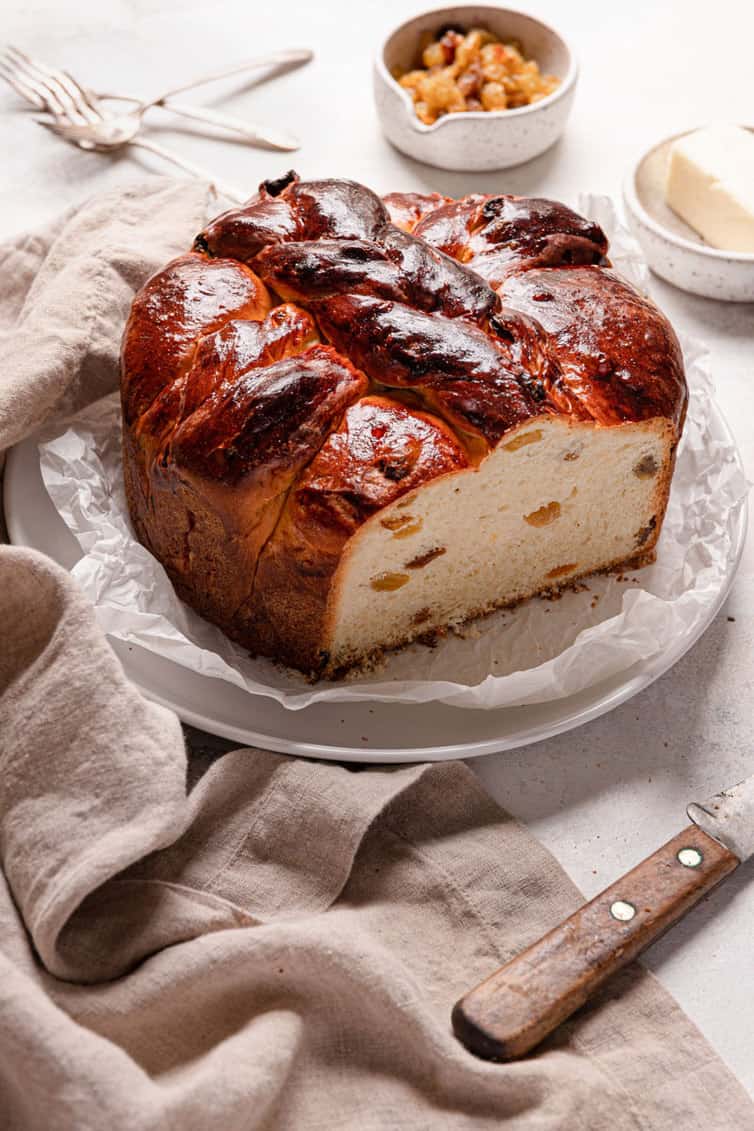
Storing, Freezing, Making Ahead
- Storing: Keep cooled paska bread in an air-tight container at room temperature for up to 3 days.
- Freezing: Wrap the cooled paska bread in a tight coat of plastic wrap followed by a layer of foil. Then store in a freezer-safe bag for up to 1 month. Thaw in the fridge overnight.
- Making ahead: You can make this 1 day in advance of serving it, to keep it as fresh as possible. Once cooled, wrap it tightly in two layers of plastic wrap and keep it at room temperature until serving.
- Leftovers: If you don’t want to freeze any of the leftover paska I would suggest slicing and using the bread in French toast or a bread pudding.

Other Delicious Easter Recipes
- Italian Easter Pie Recipe
- Bacon and Cheese Easter Bread
- Italian Easter Bread
- Koulourakia: Greek Easter Cookies
- Tsoureki: Greek Easter Bread
Paska Bread
This Easter, delight your family with a loaf of this sweet Paska Bread. Made with pantry staple ingredients, this raisin studded bread is sure to be a show-stopper! Slather it with butter, a sweet glaze, or homemade icing for a delicious treat!
If you make this Paska Bread recipe and love it, remember to stop back and give it a 5-star rating - it helps others find the recipe! ❤️️
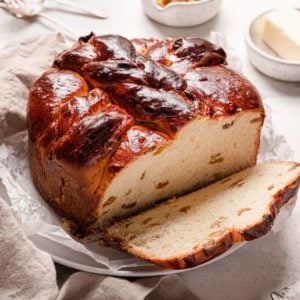
Paska Easter Bread
Ingredients
- 1 cup (240 ml) whole milk, warmed to 110 degrees F
- 2¼ teaspoons (2.25 teaspoons) instant yeast, 0.25-ounce packet
- ½ cup (99 g) granulated sugar
- ¼ cup (57 g) unsalted butter, melted and cooled to room temperature
- 2 eggs
- 1½ teaspoons (1.5 teaspoons) vanilla extract
- 4 cups (480 g) all-purpose flour
- ½ teaspoon (0.5 teaspoon) salt
- 1 cup (160 g) golden raisins, optional
For the Egg Wash:
- 1 egg
- 2 tablespoons water
- Coarse sugar, for sprinkling, optional
Instructions
- Warm the milk to between 100 to 110 degrees F (usually 30 seconds in the microwave does the trick!) and pour into a mixing bowl. Sprinkle the yeast over top and let sit for 5 to 10 minutes, until foamy.
- Add the sugar, butter, eggs, and vanilla extract, and stir to combine.
- Add the flour and the salt and stir with a wooden spoon until a shaggy dough forms. Add the golden raisins then, using the dough hook, knead on medium-low speed until a smooth, shiny ball of dough is formed, 3 to 6 minutes, adding additional flour as necessary. (You can also knead by hand until smooth ball is formed.) Place the dough in a greased bowl and cover with plastic wrap. Place in a warm, draft-free spot until doubled in size, 1 to 2 hours (rise time will depend on temperature and humidity in your kitchen).
- Punch dough down and remove from the bowl to a clean work area. Remove one-quarter of the dough and set aside. Form the large piece of dough into a ball and place in a 9-inch round cake pan or springform pan.
- Divide the remaining piece of dough into three pieces and roll them each out into a 20-inch strand. Braid the three strands together for one long braid. Divide the braid in half and use it to form a cross over the top of the large ball of dough in the pan. (Alternately, you can wrap the braid in one length around the inside edge of the pan.)
- Cover lightly with plastic wrap and let rise until puffy and nearly doubled in size, 45 to 60 minutes.
- Preheat oven to 400 degrees F.
- Whisk together the egg and water, then brush evenly all over the top of the dough and sprinkle with sugar, if desired.
- Bake for 15 minutes, then reduce the oven temperature to 350 degrees F and bake for an additional 25 to 30 minutes, until golden brown and an instant-read thermometer registers 190 degrees F. You can tent the pan with aluminum foil if it is browning too quickly. Remove from the oven, turn the bread out of the pan, and place it on a wire rack to cool completely.
Notes
- Equipment: 9-inch round cake pan or springform pan.
- Golden Raisins: You can substitute regular raisins, other chopped dried fruit, or omit entirely.
- Doubling Recipe: This recipe is easily doubled if you'd like to make two loaves - one for eating and one for gifting (or for your freezer!).
- Storing: Keep cooled paska bread in an air-tight container at room temperature for up to 3 days.
- Freezing: Wrap the cooled paska bread in a tight coat of plastic wrap followed by a layer of foil. Then store in a freezer-safe bag for up to 1 month. Thaw in the fridge overnight.
- Making ahead: You can make this 1 day in advance of serving it, to keep it as fresh as possible. Once cooled, wrap it tightly in two layers of plastic wrap and keep it at room temperature until serving.
- Leftovers: If you don't want to freeze any of the leftover paska I would suggest slicing and using the bread in French toast or a bread pudding.
Did you make this recipe?
Leave a review below, then snap a picture and tag @thebrowneyedbaker on Instagram so I can see it!
Photography by Dee Frances






My family was Russian and Croatian. My mother always made a recipe I thought was called Pashka (Sp?) It was a cheese mold stuffed with almonds, raisins, cherries, etc.
Recipe
3/4 lb cream cheese
1 stick butter
1/2 cup sour cream
1/2 cup sugar
1 cup chopped almonds
1/2 cup mixed diced candied peels and cherries
1 cup yellow raising
1 enveloped unflavored Geletin
1/4 cup cold water
Mash cream cheese, beat in butter, sour cream and sugar: beat until well blended and creamy. Add almonds, raisins, peels and cherries. Soften gelatin in cold water. Dissolve over hot water bath. Add to cheese mixture and mix well. Turn into a well oiled ring mold or bundt type cake pan. Chill in refrigerator overnight. Put on plate and decorate with additional almond slivers and diced cherries (optional)
Thank you so much for the Eastern European Paska Bread recipe. My Grandmother and Mother always made this bread for the family at Easter and I continued to make it for my family. I lost my my recipe and was in a panic. I am so grateful. Thank you!
Oh you are so welcome Mary! Enjoy!
I’m Polish and from Pittsburgh as well. We always made paska for Easter. My mom would also make loaves in a figure 8 and put the dyed Easter eggs in the holes of the figure 8. I’ve heard of babka too but thought it was the same as paska. Cake yeast is the same yeast that she is talking about on here, or at least that’s what I think, and it’s in the refrigerated section of grocery stores…normally by the butter and eggs..
Thank you for posting this!
Btw, this bread is AWESOME toasted and slathered with butter!!!
I see the raisins are optional, but do you think you could add chocolate mini chips to this bread? It looks delicious!
Hi Karen, I think mini chocolate chips would be delicious!
What about adding saffron to Paska…. always have this in my recipe. It’s expensive but it IS the flavour provider in the Paska. May as well not make Paska without the saffron😯
My Ukrainian mother-in-law from Pittsburgh always used Saffron in her Paska, plus raisins, egg wash etc and braided. After she passed I tried making it multiple times until I thought I had the proportions right. So at Easter Imade it and “presented it” to my father-in-law to taste prior to it being cut for everyone. He officially blessed it as being excellent.
I love this bread, my grandmother would make it every year for Christmas and Easter. She made it well into her 90’s until my mother took over under my Grandmother’s watchful eye. Since Grandma’s passing I have taken over the duty. The bread must be made on Good Friday with Golden raisins, so it is ready for blessing on baskets on Holy Saturday.
How much and or what is the size of a cake of yeast also does this recipe make for a fluffy light bread ?? My previous attempts at paska have produce a more dense loaf .
Thanks
Hi Michelle, One fresh cake yeast is 0.6-ounce. This is definitely a richer, denser bread, not fluffy and light.
Can the pasta bread be made in an angel food pan instead of the 3 loaf pans
Hi Joan, I’ve never made bread in an angel food pan so I couldn’t say for sure how it would turn out.
ABL, I’d like to write a post about real belief in religion and the investiture of same in Tim Tebow. And yes, I want to be the sports writer here at ABL.com. But that’s not important right now. There was quite a marriage of faith in Tebow (maybe understandable) and the Broncos (so God loves the team from Denver? huh?). I’d like to explore this on your site. Are you “game”?
What exactly does your comment have to do with a rating or review of the bread?
Thank you so much for your interest in your families’ traditional foods. The keeper of the kitchen is the cultural transmitter and the symbolism in our eating traditions play an enriching role in our cultural identities. My Polish grandparents came to Canada in the early twentieth century and I missed out on a lot of the Polish food traditions since my mom was of Irish descent, but I am trying now to lay claim to my Polish food heritage and that begins with Easter ! This week I will make your Paska recipe. What I also find interesting is that in both Ireland and in Poland, this herring parade [ beating herrings on a stick at the end of Lent] to commemorate the end of the fish reign, has found its way into both cultures. I won’t be trying that though !
My Danish mother took my Polish grandmothers same recipe and made fried doughnuts covered in dark chocolate or powdered sugar !! Some of the best doughnuts you’ve ever had! There’s a bakery in NYC , Dough , I think, that has very similar ones. Years ago, My sister and I tried but they were sinkers .I’ll stick to making the bread.
This is the same Polish Easter bread recipe my paternal grandmother used to make. I make it every year for my family and neighbors. Only difference is she used one more egg and 1/2 cup less sugar…oh and orange zest. I never knew the real name of it.
We just called it grandma’s Easter bread. Thanks for sharing and Happy Easter !
A lot of folks think I make a babka, but it is different.
( I’m waiting for the dough to rise now )
Hi! This recipe looks much more user-friendly than some other ones I came across. I am Russian, and wanted to try making a paskha for Easter this year. I have never baked a yeasted bread before though, so here is my question: how long does the dough have to rise until it doubles in size? Thanks!!
Hi Margarita, It all depends on how warm/humid your kitchen is, but generally anywhere from 1 to 3 hours.
Tasty bread, but not what I was looking for.; The crumb is fine and heavy…which upon further look is what is pictured in the photos here. I wanted something lighter and a little more bread-like. This is almost like a sweet/quick bread. And there is a lingering aftertaste of the table sugar. I won’t make this one again as I ws looking for a final product that was lighter and less crumbly, but upon retrospect my results are true to the recipe.
This dressing is a winner!! Made it last night and it was delicious! Very versatile, too.
When I originally left a comment I seem to have clicked the -Notify me when new comments are added- checkbox and from now on whenever a comment is added I get four emails with the same comment.
Is there a way you are able to remove me from that service?
Thank you!
My grandma used to make paska, a Russian Mennonite Easter tradition. Hers used quite a few eggs, and was always decorated with white icing and sprinkles. My mom doesn’t really like it, so I decided to take on the tradition now that my grandma is 98 and not baking anymore. I am happy to find a recipe that does not have citrus in it, as many of the ones I have found online do. We don’t add raisins either. Thanks for the recipe!
Thank you for this great recipe. I made a double recipe last weekend. My husband, whose Polish mother used to make wicked babka/paska breads, declared it to be “excellent”. I will make this again!
Michelle, to be traditional, the bread must be round. I use Corning Ware souffle dishes (straight sides), 8″-10″. I have even made it in a cast iron dutch oven for one huge loaf. The recipe is accurate for the slavish/Polish tradition. I grew up with my grandmother’s Easter paska. My grandparents were Polish-Ukrainian. My grandmother would make the paska, sweet poppy seed bread, homemade cheese and butter. My Grandfather would grate the freshly dug horseradish (fiery!) and add some beets to some of it to cut the heat for those who couldn’t take it plain. All of this would go into a gigantic basket along with the ham and kielbasa, with beautiful painted eggs and Easter candles, to take to church Saturday night to be blessed. It was a joyous holiday and holds special memories of my mother’s large happy family. Thanks for sharing this wonderful authentic Polish-Ukrainian recipe. My paska is rising as I write! Happy Easter
Michelle, to be traditional, the bread must be round. I use Corning Ware souffle dishes (straight sides), 8″-10″. I have even made it in a cast iron dutch oven for one huge loaf. The recipe is accurate for the slavish/Polish tradition. I grew up with my grandmother’s Easter paska. My grandparents were Polish-Ukrainian. My grandmother would make the paska, sweet poppy seed bread, homemade cheese and butter. My Grandfather would grate the freshly dug horseradish (fiery!) and add some beets to some of it to cut the heat for those who couldn’t take it plain. All of this would go into a gigantic basket along with the ham and kielbasa, with beautiful painted eggs and Easter candles, to take to church Saturday night to be blessed. It was a joyous holiday and holds special memories of my mother’s large happy family. Thanks for sharing this wonderful authentic Polish-Ukrainian recipe. My paska is rising as I write!
She’s right. My family is Ukrainian and we make this bread for every holiday… we’ve had some trouble finding the perfect round metal dishes to bake them in so we actually use dog bowls (never used by a dog before, of course). They work perfectly.
We also have horseradish with beets in it on our kielbasa!
Use the large metal coffee cans for Paska
I bookmarked this last yr and made it last night. Fantastic! My family has mad a version of this forever but the directions were very spotty. I have never baked with yeast and I needed a recipe! The torch of Paska or as we cAll it, Babka, has now been passed to me :) thanks so much fir this and for all your wonderful recipes! And love your doggies too. Happy Easter!
I’ve found this recipe a year after your post, and it looks like the best one I’ve found! The others hardly resemble paska. I will definitely try it this year. I’m originally from southern Poland near the Slovak border, and we are Roman Catholic. My parents make this every year. I didn’t know that it wasn’t Polish, however (I have always associated it with über-Polski Easter celebrations). I have heard of babka (which is popular in NYC bakeries, for example, and I’ve seen it in patisseries in Québec), but THAT I’ve never had, so the Polish paska vs babka divide must be regional. Interesting comments!
I come from Romania and we eat this on Eastern, but is a kind of pie, with cream cheese and raisins filling, we call is Pasca. it’s not really a bread, more like a sweet treat
Wonderful blog! I found it while searching on Yahoo News.
Do you have any suggestions on how to get listed in Yahoo News?
I’ve been trying for a while but I never seem to get there! Thank you
Ilive in Poland and i never heard abaut Paska bread so i think that it must be Ukrainian or Belarus. In Poland on Easter we often make Pascha (Paskha in english). You can find some information on wiki about it. On christmas traditional we make Chałka (Challah from jewish) also to see in wikipedia.
It’s so refreshing to see how many people are aware of paska bread! I am proud to say my mother kept the traditional Slovak/Polish Easter and Christmas Eve foods. I have many fond memories of making paska with her and the tradition is now passed on to my daughters. My daughter came home for this Easter and I had to wait until today to make my paska with her :)
I wanted to add that we bake our paska bread round and set some of the dough aside and roll 3 pieces to braid for the top of the bread (to represent the crown of thorns Jesus wore on Good Friday). Traditionally the bread was made on Good Friday and Easter baskets were taken to church on Saturday to have the food blessed. Sadly enough it is difficult in the area I live to find a church that stills does this.
I live in Poland and i’ve never heard about that. sounds pretty awesome though, i’ll try it for sure.
Oh my… I love paska bread! This is a family tradition that we do during every holiday! Thanks for sharing the recipe!
I love Paska bread! When I was in high school I worked at a local bakery that always sold Paska bread. However you couldn’t get a loaf until you answered the litany of Paska related questions: large loaf or small, round or square, plain or raisins, sliced or unsliced! All of their breads were terrific and when they closed it was truly a sad day.
sounds and looks alot like what we call babka! I use the base sweet dough to make a nut roll and poppyseed bread, yum :)
tri2cook.blogspot.com/2012/05/poppyseed-bread.html